Memos, memos and references: what's the difference?
The main volume of documents that provide information exchange between organizations and structural divisions are: references, memoranda and explanatory notes, summaries, reports, acts, letters, telephone messages. The information contained in these documents may inspire action or may only be taken into account. Consider the differences in the composition and design memos, memos And references.
Reporting And office notes These are usually internal documents of the organization. They are of an auxiliary nature in relation to organizational and administrative documents. In the Concise Dictionary of Types and Varieties of Documents, developed by the Main Archive of the USSR, VNIIDAD, TsGADA in 1974, definitions of these documents are given, from which some differences in their purpose follow:
- memorandum- a document addressed to the management, setting out any issue with the conclusions and proposals of the compiler.
- memo- a note on the performance of any work sent by one official to another.
memorandum
memorandum(unified form code 0286041 according to OKUD) is compiled in order to inform management about the current situation, facts that have taken place, etc. and encourage decision making.
Memos may be purely informational. Such notes contain, as a rule, information about the progress of any work. Reporting memorandums report on the implementation of tasks, plans, instructions, and work. Thus, memos provide communication of control objects at the vertical level- from the bottom up, that is, they are sent from a lower official to a higher official.
Depending on the addressee memos can be:
- internal , those. sent to the head of a structural unit or institution, and
- external - addressed to higher authorities.
Internal memorandum
Internal memos compiled on a standard sheet of paper, but indicating all the necessary details, located in accordance with GOST 6.30-2003 “Unified documentation systems. Unified system of organizational and administrative documentation. Requirements for the preparation of documents. These props include:
- name of the structural unit;
- type of document (MEMORY);
- date of;
- registration number;
- title to the text;
- text;
- destination;
- signature of the compiler (indicating the position).
The text of any information and reference document is formatted in Times New Roman font, size 14, with 1.5 spacing.
Preferably when making memorandum use the angular arrangement of the details of the header (however, this requirement is not rigid). Header Location Examples internal memorandum two ways:
In internal memorandum in the upper left corner is the name of the structural unit - the author of the document.
The name of the type of document is written in capital letters (MEMORY) and can be located in the center or from the border of the left margin (depending on the chosen method of arranging the heading of the document) after 2 line spacing.
Date and index memorandum written on one line. The date is written in Arabic numerals, for example, 02/02/2006, or in alphanumeric format, for example, February 02, 2006. external memorandum it is the date of signing and, as a rule, sending. Date internal memorandum will be the date of drafting and signing.
Registration number for internal memorandum is affixed either at the place of compilation or at the place of receipt, depending on the setting of the registration system that operates in the organization. By revising memorandum interested parties, approval visas are affixed on it, and after a decision is made, a resolution of the head. The adoption of a resolution is the final stage of consideration memorandum.
memorandum may have a heading that briefly describes the content of the document. Heading of the memorandum is formulated according to the general rules for compiling headings for documents: using the preposition "o" and a verbal noun in the prepositional case. For example: “about the translation of Koroleva O.V. to accounting."
IN the text of the memorandum two parts are clearly distinguished. The first part reports the facts that gave rise to the drafting of the document, and the second contains specific conclusions, requests and proposals. Text of the memorandum may also consist of three parts. In this case, the first part (stating) will set out the reasons, facts or events that gave rise to its writing, the second part - an analysis of the current situation, possible solutions, and the third - conclusions and proposals for specific actions that need to be taken, according to the compiler memorandum. memorandum can be presented in text and tabular form or a combination of both.
If there is an application, then a note about it is made before signing:
External memorandum
External memorandum drawn up on a common form and signed by the head of the organization. In this case, the full or abbreviated name of the parent organization is used in accordance with the charter of the organization. The name of the organization-author is placed below.
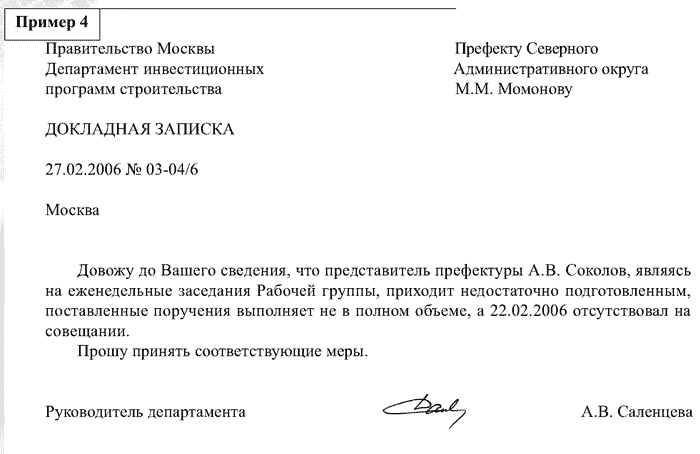
memo
In the All-Russian classifier of management documents (OKUD) there is no such type of document as " memo". However, this type of document is widely used in management practice. In this connection, we propose to draw up " memo” in accordance with the requirements of GOST 6.30-2003 “USD. USORD. Requirements for the execution of documents ”in order to unify the execution of management documentation.
Office notes, Unlike memos, provide communication of control objects at the horizontal level, that is, they are compiled by an employee or head of a unit in the name of a head or specialist of another unit. It should be remembered that office notes are usually sent from one manager to another or from one employee to another only if they have an equivalent official status, otherwise it will be memorandum.
Usually, office notes are compiled on the issues of material and technical, information, organizational and economic support. Office notes is a kind of correspondence between structural divisions. They usually contain a specific request or offer. Service notes are issued the same as reports.
An example of a memo:
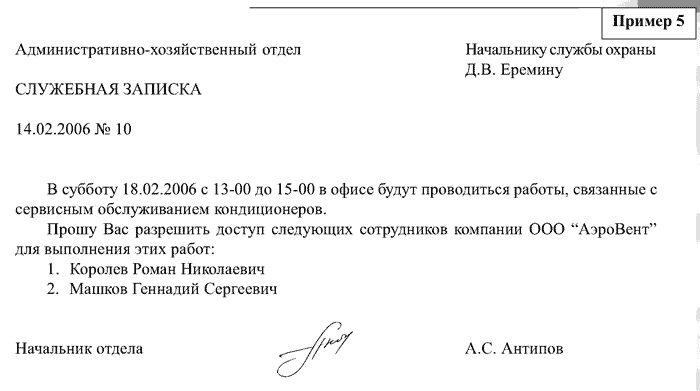
Reference
Information memorandums often replaced by such a document as a certificate, and vice versa, which is illegal. A reference is a document containing descriptions and confirmations of certain facts or events, including those of a biographical or official nature; unlike reports, it does not require any action from the manager.
Depending on the purpose of the reference, there may be:
- analytical,
- reporting or
- informational.
Analytical references contain information about the issue or problem that needs to be addressed. Usually analytical references have a significant amount of text (up to 3 pages). Analytical text consists of three parts. The first part outlines the basis for the compilation, the second - an analysis of the situation or issue, the third - conclusions and suggestions.
Reporting references contain summarizing summary information about the results of activities, therefore, the title of the reporting statement includes an indication of the time period to which the information presented in the certificate relates, for example: Statement on the volume of the enterprise's workflow in 2006.
Informational references are drawn up in order to inform the management about the state of affairs and may have, for example, the following heading: Statement of the progress of work under the contract with OJSC Luna. They are drafted upon request and submitted within the established deadlines.
References, depending on the addressee, can be:
- external and
- internal.
External references are drawn up on the general letterhead of the organization, signed by the head of the organization and contain the same details as the memos.
Internal references are drawn up on a standard sheet of paper in the same way as an internal memorandum and signed by the head of the structural unit and / or a specialist compiler.
Text of both informational and reporting reference can be formatted in the form of a table, include sections and subsections (see the example of compiling an internal certificate in Example 6).
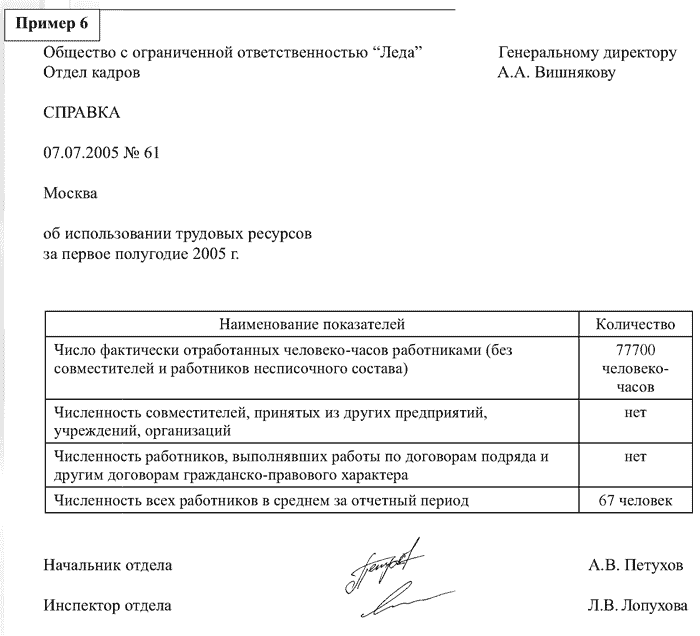
In preparation draft help it is necessary to carefully edit its content in terms of:
- completeness and reliability of facts and information;
- the correctness of the feedback means (address, telephone, etc.);
- dating accuracy;
- compliance with the signing level.
All this is necessary so that the certificate does not cause additional questions, and even more so subsequent explanatory correspondence.
Certificates of a biographical or official nature serve to certify any legal facts, for example, confirmation of a position held, salary, place of residence, etc. If the situations for which certificates are issued are typical, unified template forms are created in the organization.
Text biographical information begins with an indication in the nominative case of the surname, name, patronymic of the person about whom the information is reported. The text of any help should not contain archaic phrases containing unnecessary words like “real help”, “really works”, etc. At the end of the certificate, the name of the institution where it is submitted is given. The certificate is signed by the persons who compiled it and are responsible for the data presented. Depending on the purpose of the certificate, this may be the head of the organization and the chief accountant or the head of the organization and the head of the personnel department. Such certificates must be certified by the seal of the organization.
An example of a business certificate:

 Ready-made business plan with calculations using the example of a web studio
Ready-made business plan with calculations using the example of a web studio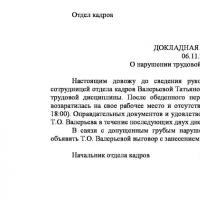 Registration of an internal memorandum: sample document and drafting rules
Registration of an internal memorandum: sample document and drafting rules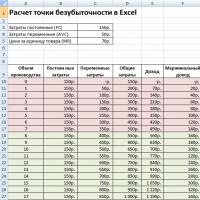 Break even. Formula. Example of model calculation in Excel. Advantages and disadvantages
Break even. Formula. Example of model calculation in Excel. Advantages and disadvantages Advance report is ... Advance report: sample filling
Advance report is ... Advance report: sample filling How to stitch documents with threads by hand?
How to stitch documents with threads by hand?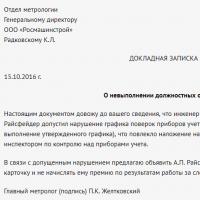 Disciplinary sanction for non-fulfillment of official duties
Disciplinary sanction for non-fulfillment of official duties Binding your book
Binding your book